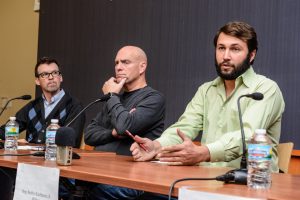Helton: What white students should know about faculty of color
The challenges faced by non-white academics go largely unnoticed by white students. Let’s change that.
The Old Capitol is seen on Thursday, Nov. 30, 2017.
April 28, 2019
We hear a lot about “diversity” at the University of Iowa. It’s one of those buzzwords ubiquitous on nice, liberal-ish college campuses such as ours. But what does diversity really mean? More pointedly, what does it mean for those with the most power?
I’m a white student. I have the privilege of not really worrying about my race or gender in this predominantly white academic setting. Out of all full-time faculty at degree-granting postsecondary institutions, 76 percent are white, according to the U.S. Education Department. The demographics are even more disproportionate with professors, where 82 percent are white (and more than half are white men).
The discrepancies are even more egregious — as they tend to be — if money is considered. If you thought the gender pay gap was bad, it’s even worse for academics of color. For every dollar a white man in higher education makes, men and women of color make 72 and 67 cents, respectively.
These are important facts to know, but the real human impact isn’t clear to individuals who want to understand these issues.
RELATED: Shaw: #DoesUIowaLoveMe? Maybe not, but there’s hope for a future where it does
I attended a UI Student Government town hall for faculty of color to talk about their experiences navigating academia. I was hoping for some more insight, but I didn’t expect to get much out of this sort of event except more talk about how “diversity is important” and other generalized statements.
But with the opportunity to speak their minds, the faculty on the panel had much more to say than just cheerleading university-sanctioned jargon and phrases.
“I think the administration here is just sort of oblivious,” said Eric Tate, an associate professor of geographical and sustainability sciences. “It’s reflected by the lack of commitment and budget.”
Communication studies Associate Professor Darrel Wanzer-Serrano said there’s sometimes willful ignorance about such issues.
“I don’t want to let people off the hook when they remain stuck in a 30-year-old paradigm of what counts as diversity,” Wanzer-Serrano said.
I realized the banal drumbeat about inclusion wasn’t including voices from people of color themselves. If I want to know the real-world implications of an under-diversified faculty, I need to listen to the right people.
After the town hall, I sat down with the third member of the panel, journalism Professor Gigi Durham. While on the panel, she noted that self-doubt and a lack of role models impaired her career. I asked her about what students such as me, who don’t face similar structural barriers, should keep in mind.
RELATED: Kumar: Represent me, UISG!
“Most of your professors have been from a certain homogenous background. I think it would be important to recognize some difference is going to add value to your education,” she said. “That’s only going to happen if you’re going to be open to the idea that a professor of color could bring some of that difference.”
So, what now? Of course, I don’t have some grand revelation to fix all the woes faculty of color face. There isn’t any single solution.
However, I do have a suggestion for white students such as me: Talk to faculty members of color. Find mentors who don’t look like you. Listen to perspectives different from your own. If we truly want college to be a diverse utopia, we’re going to need more than just nice words.






